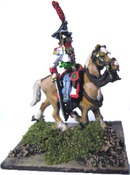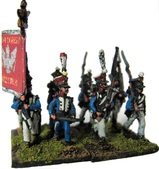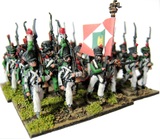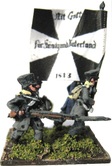The SCENARIOS
ELCHINGEN (October 1805)To complete his encirclement of Mack's army near Ulm, Napoleon orders Marshal Michel Ney to secure the Elchingen bridge over the Danube River. Can the Austrians looming on the nearby heights stop Ney's corps from closing the ring on Field Marshal Mack?
|
*This is an introductory scenario for beginners* | ||||||||
CALDIERO (October 1805)Following his victory at Ulm, Napoleon orders Marshal Messena to cross the Adige River in northern Italy and attack Archduke Charles. The Austrians defend a rugged ridgeline, but on a foggy October morning, it is Charles who makes the first move by launching a pre-emptive strike.
|
| ||||||||
|
| ||||||||||
OSTROLENKA (February 1807)Following the blood-bath at Eylau, Napoleon places General Jean Rene Savary in command of the V Corps, with orders to screen the northeastern approach to Warsaw. In mid-February, the Russians cross the Narew River to test Savary's new command at the river town of Ostrolenka.
|
| ||||||||
SIEGE of DANZIG (May 1807)Before Napoleon can continue his campaign in Poland, the French must reduce the Prussian fortress at Danzig. But on May 12, General Kamensky arrives along the Baltic Sea with a Russian relief force. Will the Russians break the French siege before Napoleon's reinforcements arrive?
|
| ||||||||
SACILE (April 1809)Archduke John of Austria drives into northern Italy with 40,000 men, forcing the local French viceroy to give battle before uniting the full French force. This viceroy is none other than Napoleon's adopted step-son, Eugene, and instead of retreating to concentrate his forces, Eugene suddenly attacks.
|
| ||||||||
|
| ||||||||||
TEUGEN-HAUSEN (April 1809)Archduke Charles has invaded Bavaria and seeks to destroy the veteran corps of Marshal Davout. Somewhat lost in the rugged Bavarian woods, the two opponents stumble upon each other. Who will emerge victorious from the confused fighting?
|
| ||||||||
RAAB (June 1809)Eugene has driven Archduke John out of Italy and the Austrians are now cornered outside Raab. If the archduke can hold his ground behind a strong defensive line, he may be able to march north, uniting with his brother Charles against Napoleon.
|
| ||||||||
KLYASTITZY (July/August 1812)In the first major engagement of the northern theater of the Russian campaign, Wittgenstein attacks Oudinot's vanguard at the village of Jakobovo. When both sides concentrate their forces, will the French clear the road to St. Petersburg?
|
| ||||||||
GORODECZNA (August 1812)Napoleon's drive on Smolensk is threatened to the south by the success of the Russian Third Army of the West. This leaves the Emperor no choice but to order his questionable Austrian allies to engage Tormassov's army. Having avoided battle thus far, will Schwarzenberg now press the attack?
|
| ||||||||
FIRST POLOTSK (August 1812)At the road junction of Polotsk, Marshal Oudinot has carelessly deployed his 35,000 men on both sides of the Dvna River. Hoping to destroy the Franco-Bavarian force piecemeal, General Wittgenstein launches a quick strike with 20,000 men. Can Oudinot recover from his mistake?
|
*This scenario has a linked 2-day option* | ||||||||
LOUBINO (August 1812)Retreating from Smolensk, Barclay de Tolly's army must pass through the crossroads of Loubino. But when two French corps stumble upon the road junction at a crucial hour, will the Russian army avoid destruction?
|
| ||||||||
|
| ||||||||
VYAZMA (November 1812)Nearly 100 miles west of Moscow, Napoleon's weary army is strung out on the road to Vyazma. Davout's corps, now the rearguard, has fallen several miles behind. The eager Russian advance guard now pounces on Davout, hoping to eliminate his corps. Will the French survive the trap?
|
| ||||||||
BEREZINA (November 1812)Trapped along the icy banks of the Berezina River, Napoleon must find a way to cross this natural obstacle while fending off two Russian armies. Can the Russians finally destroy the remnants of the Grand Army?
|
|
WEISSERITZ (Dresden, August 1813)Under the cover of a heavy midnight rain, Napoleon has greatly reinforced his army at Dresden. The rain-swollen Weisseritz River now isolates the Austrian left wing, and Napoleon orders Marshal Murat to seize this prime opportunity. Can the Austrians survive the French onslaught?
|
| ||||||||
LINDENAU (Leipzig, October 1813)As the epic Battle of the Nations rages around Leipzig, an Austrian corps threatens to cut-off Napoleon's only line of retreat. The crucial town of Lindenau protects the western approaches to the city, but can French reinforcements arrive in time to stop the Austrians from closing the ring?
|
| ||||||||
BRIENNE (January 1814)Napoleon devises a trap at Brienne to destroy Blucher's isolated force. But when Russian cossacks intercept some of the French orders, can Blucher now turn the tables on his nemesis and stop the Emperor at Brienne?
|
| ||||||||
MINCIO RIVER (February 1814)Field Marshal Bellegarde leads 35,000 men to assert control over northern Italy. But when Napoleon's step-son Eugene gathers his own army around the Mincio River, niether side is fully prepared for a pitched battle. Who will rally their scattered forces in time to land a decisive blow?
|
| ||||||||
VAUCHAMPS (February 1814)Fresh off his success at Montmirail, Napoleon gathers over 20,000 men to surprise the vanguard of Blucher's army on the road to Vauchamps. Can Napoleon end his "Six Day" campaign by eliminating two enemy corps?
|
| ||||||||
FERE-CHAMPENOISE (March 1814)In one of the most unique battles of the Napoleonic Wars, Marshals Marmont and Mortier are attacked by over 10,000 allied cavalry. Can a multi-national force comprised strictly of cavalry overwhelm the French retreat on Paris?
|
| ||||||||
|
| ||||||||||
La SOUFFEL (June 1815)Destined to be the very last battle of the Napoleonic Wars, General Jean Rapp defends the northern approaches to Strasbourg behind the
meandering Souffel River. Who will claim the final victory of the war?
|
| ||||||||



